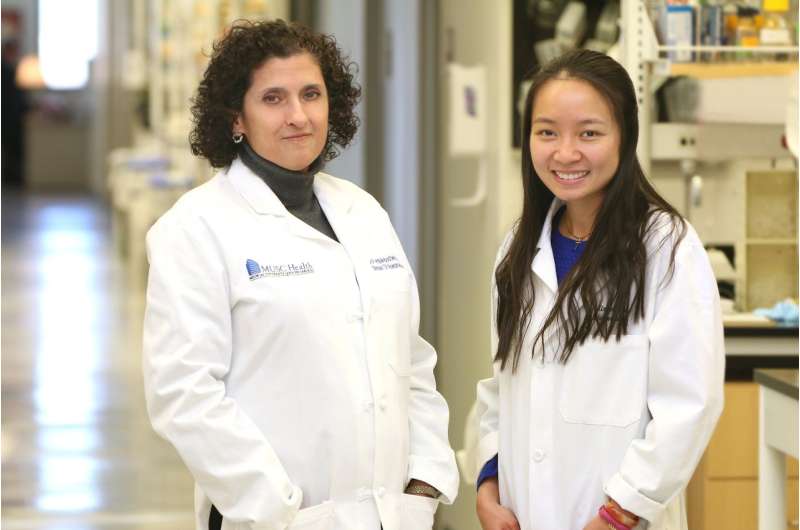Potential therapeutic target for lung fibrosis identified

In an article published online by Frontiers in Endocrinology, researchers at the Medical University of South Carolina (MUSC) report that they have identified a potential therapeutic target for lung fibrosis or scarring. They showed in a preclinical model that the protein promotes fibrosis by turning on profibrotic genes and increasing levels of profibrotic factors, including itself. It is particularly attractive as a target because it exerts its influence early, before most other profibrotic factors emerge.
"IGFBP-5 is upstream of several molecules that are considered key molecules in fibrosis, such as TGF-beta," says Carol Feghali-Bostwick, Ph.D., Kitty Trask Holt Endowed Chair for Scleroderma Research at MUSC, and senior author on the article. "So targeting it would allow us to possibly reduce the effect of all of the others that are downstream of it."
In lung fibrosis, lung tissue thickens, stiffens and scars. It can no longer function normally. That's why people with lung fibrosis have difficulty breathing.
Around 100,000 Americans have lung fibrosis without a known cause, known as idiopathic pulmonary fibrosis. Another 50,000 have scleroderma, an autoimmune disease that often leads to lung fibrosis as well as thickening and tightening of the skin.
"There are currently no FDA-approved drugs that can either stop disease progression or reverse it in these patients," says Feghali-Bostwick. "Mortality is high, in some cases higher than cancer, so finding therapies is critical."
For these patients, transplant is often the only option. However, not all patients are eligible for lung transplant, and it is not without its complications. New therapies that can stop or reverse lung fibrosis are needed.
Feghali-Bostwick and her team showed that insulin-like growth factor-binding protein 5 (IGFBP-5) plays an important and early role in promoting fibrosis. It increases profibrotic gene expression, resulting in excessive collagen being deposited to the extracellular matrix (ECM). The ECM is the network that surrounds cells and serves as the scaffold on which they can build tissue. This excess collagen causes the tissue to stiffen and become fibrotic.
These profibrotic genes also help ensure that levels of IGFBP-5 and other profibrotic factors such as matrix crosslinking enzyme lysyl oxidase (LOX) stay high. LOX enables collagen fibrils to cross-link, making tissue stiffer.
"IGFBP-5 induces its own gene expression and feedback loop," says Xinh Xinh Nguyen, a graduate student who is working with Feghali-Bostwick and first author on the article. "This suggests that IGFBP5 acts together with profibrotic genes to promote fibrosis and tissue remodeling."
The MUSC used collagen-producing cells harvested from patients with IPF or scleroderma to explore the profibrotic effects of IGFBP-5. But they also went a step further, showing similar increases in human lung tissue cores. These cores more realistically mimic the physiologic conditions of living human tissue.
"It's important to understand the effects of IGFBP5 in human tissue if you are developing therapies," explains Feghali-Bostwick. "Many therapies work in mice but fail in humans when you get to the human trials. So we have this system where we take lung tissues and put them in an environment that's a human-based tissue."
Next steps are to use collagen-producing cells and human lung tissue cores to better understand how the increased levels of LOX caused by IGFBP-5 further promote fibrosis. The MUSC team will also study LOX in a transgenic mouse model that is engineered to overexpress IGFBP-5.
This important translational discovery was made possible by the South Carolina Clinical and Translational Research (SCTR) Institute's TL1 predoctoral training program, which instills in graduate students the skills they will need to translate their basic science research to the clinic. Nguyen is a TL1 trainee, and Feghali-Bostwick is her mentor as well as the associate TL1 program director.
"The TL1 program is critical in training the next generation of scientists and physician-scientists who can move discoveries from the bench to the clinic," explains Feghali-Bostwick. "Graduate students are our pipeline for the future, and this program teaches them about how to have the right mindset and think about translational research and clinically relevant research."
"Participation in the TL1 program has provided me additional learning opportunities to gain expertise in translational research," says Nguyen. "It has enhanced my knowledge about clinically relevant aspects of my project."
Nguyen was able to shadow Deanna Baker Frost, M.D., Ph.D., an assistant professor in the MUSC College of Medicine, as she saw patients with scleroderma. Baker Frost is participating in SCTR's Institutional Career Development KL2 program, which focuses on preparing early-career scientists and physician-scientists for translational research.
"Xinh Xinh (Nguyen) is doing research on scleroderma, but now she understands better what scleroderma is and understands what patients go through and what their complications are and what they come in for," explains Feghali-Bostwick. "That puts it all in perspective and helps her better understand why she is doing the research she is doing."
Feghali-Bostwick believes that there is a natural mentoring relationship between the KL2 and TL1 scholars. "There is less of a gap between them than between senior scientists like myself and TL1s," she says. "It's a good fit; it's a natural fit."
More information: Xinh-Xinh Nguyen et al, IGFBP-5 Promotes Fibrosis via Increasing Its Own Expression and That of Other Pro-fibrotic Mediators, Frontiers in Endocrinology (2018). DOI: 10.3389/fendo.2018.00601



















